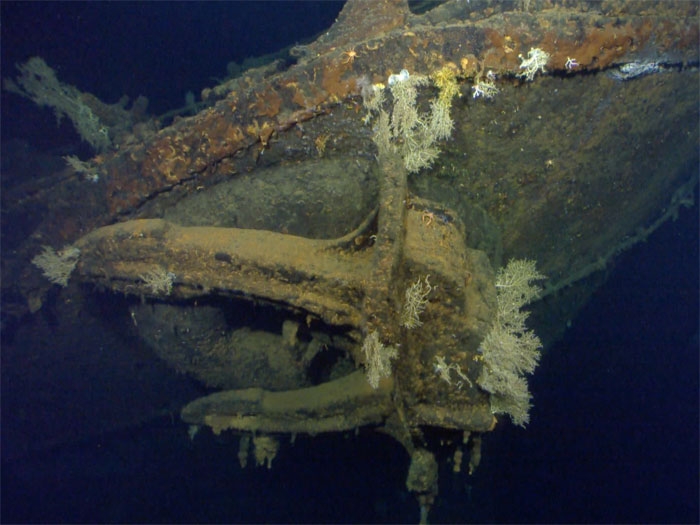
Microsoft billionaire finds lost WWII Japanese battleship
Written by Nick Blenkey
The Musashi carried two 15-ton anchors. The starboard anchor remains in place.
MARCH 4, 2015 — An expedition mounted by billionaire investor and philanthropist Paul Gardner Allen, a co-founder of Microsoft, has located the Japanese battleship Musashi, sunk by American forces on October 24, 1944 in the lead up to the Battle of Leyte Gulf. Despite numerous eyewitness accounts, the exact location of the ship was unknown.
The Musashi and her sister ship Yamato were the heaviest and most powerfully armed battleships ever constructed. This year marks the 70th anniversary of the conclusion of World War II, and the finding of the battleship is a significant milestone in the annals of naval history.
Mr. Allen and his team of researchers began their search for the Musashi more than eight years ago. Using historical records from four countries, detailed undersea topographical data and advanced technology aboard his yacht, M/Y Octopus, Mr. Allen and his team located the battleship in the Sibuyan Sea on March 1, 2015.
The team combined historical data with advanced technology to narrow the search area. Mr. Allen commissioned a hypsometric bathymetric survey of the ocean floor to determine the terrain. This data was used to eliminate large areas for the search team and also resulted in the discovery of five new geographic features on the floor of the Sibuyan Sea.
In February 2015, the team set out to conduct the final phase of the search using a BlueFin-12 Autonomous Underwater Vehicle (AUV). Because the search area had been so narrowly defined by the survey, the AUV was able to detect the wreckage of Musashi on only its third dive.
A Remote Operated Vehicle (ROV) with a high-definition camera confirmed the identity of the wreckage as Musashi, the second ship in the Yamato class.
“Since my youth, I have been fascinated with World War II history, inspired by my father’s service in the U.S. Army,” said Mr. Allen. “The Musashi is truly an engineering marvel and, as an engineer at heart, I have a deep appreciation for the technology and effort that went into its construction. I am honored to play a part in finding this key vessel in naval history and honoring the memory of the incredible bravery of the men who served aboard her.”
Commissioned in 1942, and weighing in at 73,000 tons fully loaded, the Musashi featured eighteen inch armor plating and was armed with nine eighteen-inch guns, the largest ever mounted on a warship.
Utmost secrecy was maintained by the Mitsubishi Shipyard in Nagasaki during the construction; the entire length of the ship was hidden from view to prevent the Allied Forces from learning of its construction.
Active in several battles, including the Battle of the Philippine Sea, the Musashi was eventually sunk by an estimated 19 torpedoes and 17 bombs on October 24, 1944 in the lead up to the Battle of Leyte Gulf. Of Musashi’s 2,399 crew members, nearly half lost their lives including the Commander Vice Admiral Toshihira Inoguchi.
Mr. Allen and his research team say they are mindful of the responsibility related to the wreckage of the Musashi as a war grave and intend to work with the Japanese government to ensure the site is treated respectfully and in accordance with Japanese traditions.
At 414-feet long, Mr. Allen’s M/Y Octopus is one of the world’s largest and most recognizable yachts. Launched in 2003, Octopus is a private vessel that is regularly loaned out for exploration projects, scientific research initiatives and rescue missions.
Octopus was inspired by recollections of Jacques Cousteau’s underwater adventures and a curiosity about what lies beneath the ocean’s surface.
Mr. Allen has called Octopus “less a Bentley than a Range Rover,” to describe how it was built to explore the oceans, accommodate state-of-the-art equipment and carry crews of scientists. It is outfitted with a 10-person commercial-class scientific exploration submarine called Pagoo which can dive for up to eight hours, and a remotely operated vehicle (ROV) that the crew has dubbed Octo ROV. The ROV can descend 8,843 feet and contains a broadcast-quality video camera that is used to capture underwater footage, which is often donated for use in documentary films.
Recent projects include collaborating on Google Earth’s “Explore the Ocean” feature, helping Discovery Science Channel capture footage for a documentary to study the effects of nuclear detonation on the marine environment and loaning Octopus to the Royal Navy in an effort to recover the culturally iconic bell from the wreckage of the HMS Hood.





Leave a Reply
You must be logged in to post a comment.